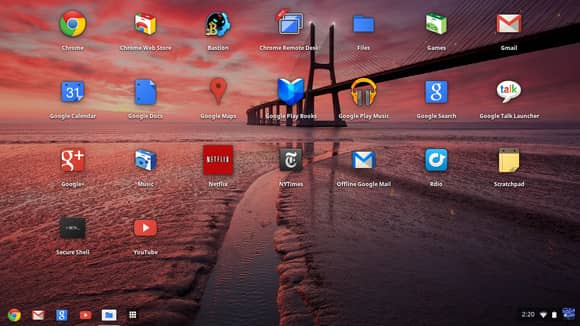There's no doubt that Google is very brave to take on Microsoft and Apple with their Chrome operating system. Originallly launched last year the cloud-based OS didn't really make the impact Google had hoped for.
Well, they're back with version 2.0 and two new Chromebooks to see if they can change the landscape of personal computers again. At the centre of the revamp is the Chromebox desktop solution, which looks to give users a bit of the familiar when it comes to a completely new operating system.
The concept
The concept of Cloud computing is that all files and applications are in the cloud - so when ever you need to do some work you go online and use a wealth of HTML apps, cloud storage and online docs. The benefits of Chrome books are that they’re cheep, very fast and a safer way to work.
First of all, Chrome OS is not for hardcore PC and Mac users - you're not going to be able to do high-end, processor intensive functions like Photo editing, music production or play triple A games.
It's squarely aimed at users who use the internet as the main resource for their computer, there are still a range of issues with Chrome OS; the selection of apps, the lack of offline support and a lack of core alternative apps.
As we mentioned earlier power users aren't going to be able to dump their Macs and PC's in favour of a Chrome book. One day this might happen, but it won't happen until software makers make their most popular apps available to work within a browser - small steps are being taken to acievie this, but we're not quite there just yet.
The Chrome Web Store isn't going to compete with the variety of iOS or the openness of Google Android – but times are changing and over the next few years it could become a viable alternative to buying/downloading software.
Although it’s certainly not got everything you might want (no official Spotify app, no Photoshop, no Microsoft products like Live) its certainly got plenty to keep you occupied.
What’s new
The major drawback of a cloud-based OS is, of course, when you have no Internet connection. The current computer world has been anchored in the world of offline for a very long time; are we ready to move into the cloud? Well, not just yet.
Google has tried to address this downside by allowing an offline mode for Gmail. But, there is still no Google docs offline - which they're promising in the next couple of weeks, but any significant delay on this could prove to be a nail in the coffin of this OS.
Google has tried to address the offline conundrum by allowing users to copy apps to flash drives so you can still open files when you're not online. The files accessible include Office docs, PDF, ZIPs, RARs and movie and sound files.
When you go back online the system will synch with the cloud and Google is promising support for their other Cloud service Google Drive.
The desktop is back
When Google announced the last version of Chrome OS the system didn't have a desktop, there was no multitasking and there was no task bar. Unfortunately this streamlined vision of the future didn't really make sense - this time around Google has added all three and they're the most significant changes.
While these changes are most welcome, but you can't help but think Google hasn’t really got a grasp on the ultimate direction of Chrome OS. Obviously these changes make the UI much closer to Mac OS and Windows – which for many is a good thing.
The new desktop allows you to host pictures, apps and shortcuts on it. You can also move and resize your various tabs and tasks, and display things like Hangouts on the desktop. Along the bottom of the screen in the new Chrome OS taskbar where you can you pin your most used apps to it. It’s certainly a welcome change, but you can’t help but think it’s a step backwards.
The benefits of the Cloud
It’s not all doom and gloom when it comes to cloud computing as there are some huge advantages. Google reckons you’ll never have to worry about malware or viruses as updates are managed server side and storage is handled by Google themselves.
One of the best things about Chrome OS is the speed of it; you can boot it in a flash, much like a tablet – it might not sound like much, but for a laptop it’s a welcome addition and is something PC’s and Mac’s can only dream of.
It’s obvious that Google Chrome OS is major step in the right direction, and the major downsides (poor 3G coverage and apps) aren’t really anything Google can fix themselves – when 4G is prevalent in the UK and more apps are made available it’s going to be hard not to be seduced by the advantages of cloud computing.
Conclusion
You can’t help but think we’re looking at the future a personal computing, it’s still got some major obstacles to overcome, but the foundation has been laid in this update to make Chrome OS a viable, cheap, alternative to Mac OS and Windows. Chrome OS has become a good deal more acceptable to the mass market and a giant leap towards becoming an acceptable second machine.
The offline Google Docs access and the Google Drive integration are critical updates for Chrome OS, but if we take Google at its word then it is a matter of weeks before this is rolled out. If it improves as much in the next 12 months we may well have a viable new computing system coming to our lives.

